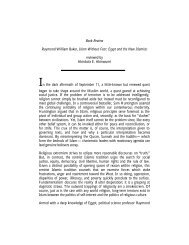Michael J. Thompson Stephen Eric Bronner Wadood Hamad - Logos
Michael J. Thompson Stephen Eric Bronner Wadood Hamad - Logos
Michael J. Thompson Stephen Eric Bronner Wadood Hamad - Logos
Create successful ePaper yourself
Turn your PDF publications into a flip-book with our unique Google optimized e-Paper software.
Stanley Aronowitz<br />
<strong>Logos</strong> 2.3 – Summer 2003<br />
I<br />
C. Wright Mills is exemplary of a vanishing breed in American life: the public<br />
political intellectual who, despite his grating message, often received a hearing<br />
in mainstream media. For almost fifteen years, beginning with the publication<br />
of The New Men of Power in 1948 and ending with his untimely death, at age<br />
forty six, in 1962, Mills was among America’s best known social scientists and<br />
social critics. During the late 1940s and 1950s he published three books that<br />
constitute a theory and description of the post-World War II American social<br />
structure. His Sociological Imagination remains widely read in college<br />
classrooms, both for its attempt to provide a socially-committed introduction<br />
to the discipline, and its fierce critique of the prevailing tendencies in American<br />
sociology, what Mills calls “Grand Theory” and “Abstracted Empiricism.” The<br />
grand theorist’s scope is much too wide to yield practical and theoretical<br />
insight. And Mills criticizes the legions of Abstracted Empiricists who, in the<br />
service of incrementally accumulated verifiable scientific knowledge, confine<br />
themselves to producing small-scale investigations. Together with his<br />
collaborator and mentor, Hans Gerth, he edited one of the earliest and best<br />
collections in English translation of Max Weber’s essays. And Character and<br />
Social Structure (1954), written with Gerth, an unjustly neglected work, may<br />
be considered Mills’s premier work of social theory. This book elaborates what<br />
I claim was the “scaffolding” upon which he hung his major works of middle<br />
range theory, especially the triology. In fact, it is difficult to fully comprehend<br />
the harsh critiques of Sociological Imagination, and Mills’s method, without the<br />
elaborated theoretical framework of Character.<br />
While not exactly a household name, he was widely known among the<br />
politically active population and wide circles of academic and independent<br />
intellectuals. Unlike many public intellectuals he was neither a servant nor a<br />
supplicant of power but, in the sense of the 17th century English radical, was a<br />
“ranter”; in American terms, he was a Paul Revere whose job it was to sound<br />
the alarm. Indeed, some of his writings recall the pamphlets of the decades of<br />
the American revolution where the address of numerous and often anonymous<br />
writers was to the “publick” of small farmers and artisans, as much as to those<br />
holding political and economic power. Much of his later writing may be




